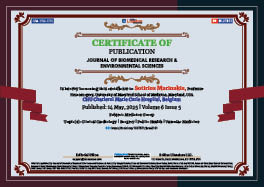Naila El Nakadi, Sebastien Du2019ulisse, Karim Homsy, Serge Cappeliez, Badih El Nakadi and Sotirios Marinakis*
Volume6-Issue5
Dates: Received: 2025-04-08 | Accepted: 2025-05-10 | Published: 2025-05-14
Pages: 439-443
Abstract
Background: Minimally Invasive Coronary Revascularization (MICS-CABG) has been performed for over 20 years; however, their technical complexity, steep learning curves and absence of training programs explain the weak acceptance of these techniques. Multivessel coronary pathology consists of an extra challenge for complete revascularization in a minimally invasive setup. Cardiopulmonary bypass with cardiac cardioplegic arrest gives the possibility to a minimally invasive full coronary revascularization despite the complexity of coronary lesions.
Objectives: The aim of this article is to report on our short-term outcomes and to share our experience on multivessel MICS-CABGs with aortic crossclamp on our 40 first consecutive patients.
Methods: All patients who benefited from a scheduled multivessel MICS-CABG with aortic crossclamp in our hospital, from February 2022 to November 2023 (n = 40) were identified. Baseline demographics, peri, postoperative and laboratory data were extracted from each patient’s medical records. The 30 days results were reported.
Results: We started our minimal invasive coronary artery program on July 2018. However, difficulty addressing every coronary pathology in a minimally invasive off pump operation motivated us to adopt femorofemoral cardiopulmonary bypass and aortic crossclamp for patients with multivessel MICS-CABGs. The first 5 patients were operated on using a right thoracoscopic approach for aortic crossclamp. For the remaining 35 we adopted the TCRAT (Total Coronary Revascularization via Left Thoracotomy) technique with aortic crossclamp from the left. The average number of coronary anastomoses was 3.5 +/- 0.75, with aortic cross-clamp time 126 +/- 25min and total extracorporeal circulation (ECC) 166 +/- 36min. One Major Adverse Cardiac Event (MACE) was observed which was a death at postoperative day 9 due to pneumonia infection. Twenty-two patients were operated through the 3rd intercostal space and 18 from the fourth. Left internal mammary artery was harvested either thoracoscopically or under direct view regarding patient’s anatomy.
Conclusions: Multivessel MICS-CABG is a technically demanding operation. ECC and heart cardioplegic arrest expand MICS-CABGs indications to almost every patient.
FullText HTML
FullText PDF
DOI: 10.37871/jbres2101
Certificate of Publication

Copyright
© 2025 El Nakadi N, et al. Distributed under Creative Commons CC-BY 4.0
How to cite this article
El Nakadi N, D’ulisse S, Homsy K, Cappeliez S, El Nakadi B, Marinakis S. Multivessel Minimally Invasive Coronary Bypass with Aortic Crossclamp. Experience with 40 First Patients. J Biomed Res Environ Sci. 2025 May 12; 6(5): 439-443. doi: 10.37871/jbres2101, Article ID: JBRES2101, Available at: https://www.jelsciences.com/articles/jbres2101.pdf
Subject area(s)
References
- Benetti FJ, Ballester C. Use of thoracoscopy and a minimal thoracotomy, in mammary-coronary bypass to left anterior descending artery, without extracorporeal circulation. Experience in 2 cases. J Cardiovasc Surg (Torino). 1995 Apr;36(2):159-61. PMID: 7790335.
- McGinn JT Jr, Usman S, Lapierre H, Pothula VR, Mesana TG, Ruel M. Minimally invasive coronary artery bypass grafting: dual-center experience in 450 consecutive patients. Circulation. 2009 Sep 15;120(11 Suppl):S78-84. doi: 10.1161/CIRCULATIONAHA.108.840041. PMID: 19752390.
- Babliak O, Demianenko V, Melnyk Y, Revenko K, Pidgayna L, Stohov O. Complete Coronary Revascularization via Left Anterior Thoracotomy. Innovations (Phila). 2019 Aug;14(4):330-341. doi: 10.1177/1556984519849126. Epub 2019 May 20. PMID: 31106625.
- Oehlinger A, Bonaros N, Schachner T, Ruetzler E, Friedrich G, Laufer G, Bonatti J. Robotic endoscopic left internal mammary artery harvesting: what have we learned after 100 cases? Ann Thorac Surg. 2007 Mar;83(3):1030-4. doi: 10.1016/j.athoracsur.2006.10.055. PMID: 17307454.
- Marinakis S, Homsy K, Nakadi BE. Evolution of Surgical Expertise in Endoscopic Assisted Minimally Invasive Coronary Artery Bypass: Experience With 70 Consecutive Patients. Innovations (Phila). 2024 Mar-Apr;19(2):207-209. doi: 10.1177/15569845241237482. Epub 2024 Apr 4. PMID: 38576097.
- Marinakis S, Chaskis E, Cappeliez S, Homsy K, De Bruyne Y, Dangotte S, Poncelet A, Lelubre C, El Nakadi B. Minimal invasive coronary surgery is not associated with increased mortality or morbidity during the period of learning curve. Acta Chir Belg. 2023 Oct;123(5):481-488. doi: 10.1080/00015458.2022.2076971. Epub 2022 May 20. PMID: 35546309.
- Marinakis S, Lalmand J, Cappeliez S, De Bruyne Y, Viste C, Aminian A, Dolatabadi D, El Nakadi B. An asymptomatic Lima dissection after a programmed hybrid revascularization procedure turned to nightmare. Acta Chir Belg. 2022 Oct;122(5):370-372. doi: 10.1080/00015458.2020.1871289. Epub 2021 Jan 21. PMID: 33399525.
- Yilmaz A, Robic B, Starinieri P, Polus F, Stinkens R, Stessel B. A new viewpoint on endoscopic CABG: technique description and clinical experience. J Cardiol. 2020 Jun;75(6):614-620. doi: 10.1016/j.jjcc.2019.11.007. Epub 2020 Jan 8. PMID: 31926795.
- Sandner S, Misfeld M, Caliskan E, Böning A, Aramendi J, Salzberg SP, Choi YH, Perrault LP, Tekin I, Cuerpo GP, Lopez-Menendez J, Weltert LP, Böhm J, Krane M, González-Santos JM, Tellez JC, Holubec T, Ferrari E, Doros G, Vitarello CJ, Emmert MY; Registry Investigators; European DuraGraft Registry investigators’. Clinical outcomes and quality of life after contemporary isolated coronary bypass grafting: a prospective cohort study. Int J Surg. 2023 Apr 1;109(4):707-715. doi: 10.1097/JS9.0000000000000259. PMID: 36912566; PMCID: PMC10389413.
- Singh K, Anderson E, Harper JG. Overview and management of sternal wound infection. Semin Plast Surg. 2011 Feb;25(1):25-33. doi: 10.1055/s-0031-1275168. PMID: 22294940; PMCID: PMC3140234.






























































